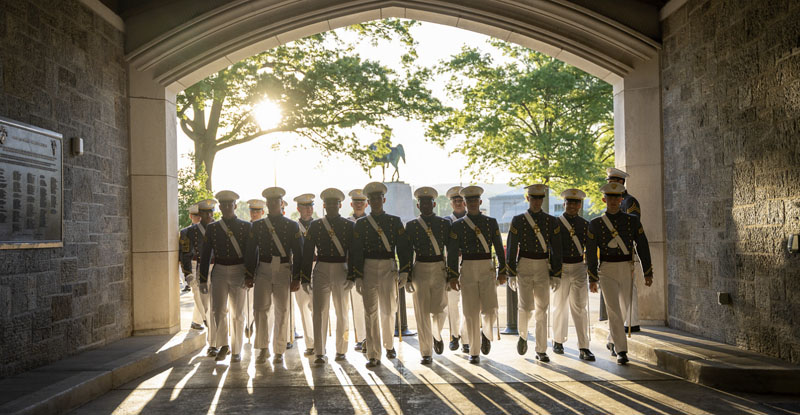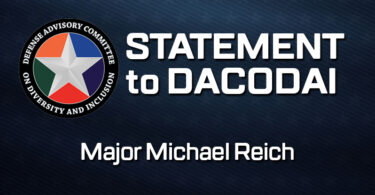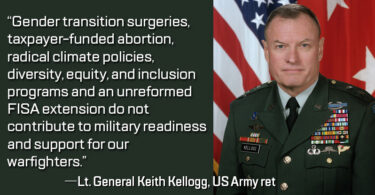By Major Geoffrey Irving, U.S. Marine Corps Reserve
The armed forces should be prepared for the end of affirmative action if the Supreme Court rules for the plaintiffs in Students for Fair Admissions v. University of North Carolina (SFFA v. UNC).1
Based on the current conservative composition of the court, and transcripts from oral arguments, it is likely the court will overturn the precedent allowing consideration of race in postsecondary education admissions.
While SFFA v. UNC focuses on civilian, public academic institutions such as the University of North Carolina, the armed forces should be prepared for the retreat of race-conscious selection policies in both its service academy admissions and recruiting practices and be ready to answer the following questions:
Does the military have a compelling governmental interest in achieving a certain level of racial diversity among its enlisted and officer corps?
If so, are current admissions and recruiting practices narrowly tailored to meet that compelling interest?
SFFA v. UNC is the latest to challenge the two-decade-old Supreme Court decisions in Grutter v. Bollinger and Gratz v. Bollinger, which upheld the consideration of race in postsecondary education admission (colloquially known as affirmative action”).2
There is a long history of jurisprudence on regulating the U.S. government’s using use of racial classifications to make decisions.
While this is not a comprehensive overview, it is helpful to review the basic legal history of affirmative action, and the military’s inputs throughout, to understand the issues before the court. . . . (read more at US Naval Institute Proceedings)
From the article, Justice O’Connor’s views on limiting “race-conscious admissions”:
“Moreover, while recognizing the value of diversity, Justice O’Connor declared that “[R]ace-conscious admissions policies must be limited in time” so as to ensure “all citizens that the deviation from the norm of equal treatment of all racial and ethnic groups is a temporary measure.”
She cautioned that colleges and universities should continually reassess their admissions policies to see whether changed circumstances allowed schools to maintain diversity without affirmative action, and she expressed the expectation “that 25 years from now, the use of racial preferences will no longer be necessary to [achieve diversity].”
Although some have seen in this language a mandate to terminate race-conscious admissions by 2028, O’Connor was expressing an expectation. Read literally she rested the termination of affirmative action on changed circumstances. One commentator has suggested that the current Court’s legitimacy maximizing option is to avoid overruling Bakke by endorsing O’Connor’s termination deadline and making it a mandate. I don’t see this happening. The Court’s conservative majority seems eager to declare race-conscious admissions dead as a matter of principle. For them race-based admissions have always been unconstitutional.”
By Scott McQuarrie (West Point graduate, former infantry officer, lawyer)
Few legal commentators think about the military/service academies when considering the potential outcomes in the Harvard/UNC cases, and few are aware of some justices’ aversion to ruling against an official position of DoD. That might explain the lack of a comment about a military carve out possibility.
In Harvard/UNC (unlike in all previous SCOTUS cases on this subject, including the 2003 Grutter case in which Justice O’Connor wrote the majority opinion you cite), DoD has taken an official position (via its amicus brief, and reiterated expressly at oral argument by the US Solicitor General) urging the court to allow the use of “race conscious” admissions policies especially at the service academies, claiming that there is, as to them, a national security imperative justifying their continued use.
Some SCOTUS justices are very reluctant to believe they know more about how to defend the country (here, what is or is not essential to national security) than do civilian and uniformed defense leaders. They therefore tend to defer to whatever DoD officially says is necessary for DoD to do (even when DoD’s evidence is thin).
Here, DoD was not a party to the case, and there was no “record” (evidence) developed through the litigation process relating to DoD’s position. Most information regarding DoD’s claims is found in the amicus briefs of DOD/United States, the Reeder group, and Veterans For Merit (VFM). But that is all considered helpful, but not the product of vigorous litigation (discovery and rules of evidence), so of limited value to the court.
At oral argument, a few questions from Chief Justice Roberts addressed the service academies, and he commented that this might not be the case to decide the issues/claims relating to them.
This reluctance is why we published articles in national publications that we were told SCOTUS clerks read – attempting to educate the clerks and their justices so that they would become comfortable and confident ruling in a manner that rejects DoD’s official, “national security imperative” claim. But those articles were nothing but opinion pieces, so may be deemed unpersuasive in this context.
Most lawyers involved in the case from the students’ side (with whom I am involved), believe it unlikely that the court will expressly include DOD/the service academies (by mentioning that their ruling applies to them, as well) in their rulings, assuming those rulings are to ban generally the consideration of race in college admissions.
They believe instead that it’s likely the majority opinion will be silent regarding the applicability of their ruling to DoD/service academies, and that there’s a small chance that a majority (assuming the majority rules to ban the use of race in admissions) could even expressly exclude DoD/service academies from their ruling (a “carve out”). We hope that does not happen, and I would consider majority opinions that ban consideration of race generally, but that are silent regarding DoD/service academies, as a good “win.”
It’s also possible that the applicability of the majority’s basic rulings to DoD/service academies (exempting or expressly including them) could be addressed in one or more concurring or dissenting opinions. Such language would not be part of the majority opinion, and thus not dispositive of what the law is, but could be instructive regarding the views of whichever justice(s) authors or joins in any such opinion. For example, the majority opinion could be silent about the service academies, but a concurring opinion(s) could say that the author would extend the ruling to the service academies.
It’s hazardous to try to guess what the court will do. We will know very soon, ending the guessing and setting up the next battle(s). The next battles will likely include the constitutionality of “facially race neutral” mechanisms colleges use to influence the demographic makeup of their student bodies where those mechanisms disparately impact one or more racial groups (see the recent Coalition for TJ opinion from the 4th Circuit involving a premier, magnet high school) and this article: https://dersh.substack.com/p/are-universities-preparing-to-circumvent?publication_id=373575&isFreemail=true








Leave a Comment